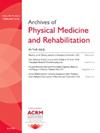Randomized Trial Assessing Prospective Surveillance and Exercise for Preventing Breast Cancer-Related Lymphedema in High-Risk Patients
IF 3.7
2区 医学
Q1 REHABILITATION
Archives of physical medicine and rehabilitation
Pub Date : 2025-08-01
DOI:10.1016/j.apmr.2025.03.002
引用次数: 0
Abstract
Objective
To evaluate if combining a prospective surveillance model (PSM) with a supervised multimodal exercise program prevents breast cancer-related lymphedema (BCRL) and its effect on the functional capacity and quality of life (QoL) of high-risk breast cancer (BC) patients undergoing treatment.
Design
Two-arm parallel superiority randomized controlled trial.
Setting
Outpatient physical therapy service in a public hospital.
Participants
116 adult women (N=116; age ≥18y) diagnosed with stage I-III BC were enrolled. Inclusion criteria included recent surgery and indication for adjuvant chemotherapy. Exclusion criteria were significant arm volume difference, previous cancer, exercise contraindications, and extreme body mass index values.
Interventions
Participants were randomized into experimental (n=61) or control groups (n=55) in a 1:1 ratio. The experimental group received PSM with a supervised multimodal exercise program for 12 weeks. The control group received PSM alone.
Main Outcome Measures
Arm volume, grip strength, 6-minute walk test, and QoL were blindly assessed at baseline, 3, 6, and 9 months.
Results
The combination of PSM with a supervised multimodal exercise program significantly reduced arm volume and body weight and improved grip strength, functional capacity, and the QoL of patients.
Conclusions
Combining PSM and physical exercise reduces arm volume, prevents BCRL, and improves physical performance and QoL in high-risk patients. The combination of PSM and STRONG-B was superior to PSM alone, validating the study's superiority design.
评估前瞻性监测和运动预防高危患者乳腺癌相关淋巴水肿的随机试验。
目的:评估将前瞻性监测模型(PSM)与监督下的多模式锻炼计划相结合是否可以预防乳腺癌相关淋巴水肿(BCRL),以及其对接受治疗的高危乳腺癌(BC)患者的功能能力和生活质量(QoL)的影响:116名确诊为I-III期乳腺癌的成年女性(≥18岁)。纳入标准包括近期手术和辅助化疗指征。干预措施:参与者按 1:1 的比例随机分为实验组(61 人)和对照组(55 人)。实验组接受为期 12 周的 PSM 和有监督的多模式锻炼计划。主要结果指标:在基线、3、6 和 9 个月时对患者的手臂体积、握力、6 分钟步行测试和 QoL 进行盲法评估。结果:将 PSM 与有指导的多模式锻炼计划相结合,可显著减少患者的手臂体积和体重,改善握力、功能能力和 QoL。PSM 和 STRONG-B 的组合优于单独使用 PSM,验证了该研究的优越性设计。
本文章由计算机程序翻译,如有差异,请以英文原文为准。
求助全文
约1分钟内获得全文
求助全文
来源期刊
CiteScore
6.20
自引率
4.70%
发文量
495
审稿时长
38 days
期刊介绍:
The Archives of Physical Medicine and Rehabilitation publishes original, peer-reviewed research and clinical reports on important trends and developments in physical medicine and rehabilitation and related fields. This international journal brings researchers and clinicians authoritative information on the therapeutic utilization of physical, behavioral and pharmaceutical agents in providing comprehensive care for individuals with chronic illness and disabilities.
Archives began publication in 1920, publishes monthly, and is the official journal of the American Congress of Rehabilitation Medicine. Its papers are cited more often than any other rehabilitation journal.

 求助内容:
求助内容: 应助结果提醒方式:
应助结果提醒方式:


